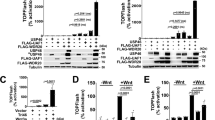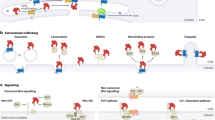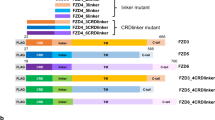Abstract
Cell to cell communication is vital throughout the development of multicellular organisms and during adult homeostasis. One way in which communication is achieved is through the secretion of signaling molecules that are received by neighboring responding cells. Wnt ligands comprise a large family of secreted, hydrophobic, glycoproteins that control a variety of developmental and adult processes in all metazoan organisms. By binding to various receptors present on receiving cells, Wnts initiate intracellular signaling cascades resulting in changes in gene transcription. Misregulation of Wnt signaling contributes to cancer and other degenerative disorders; thus, much effort has been made to understand the ways in which the pathway is controlled. Although ample research into the regulatory mechanisms that influence intracellular signaling events has proved fruitful, a great deal still remains to be elucidated regarding the mechanisms that control Wnt protein processing and secretion from cells, transport through the extracellular space, and protein reception on neighboring cells. This review attempts to consolidate the current data regarding these essential processes.
This is a preview of subscription content, access via your institution
Access options
Subscribe to this journal
Receive 50 print issues and online access
$259.00 per year
only $5.18 per issue
Buy this article
- Purchase on Springer Link
- Instant access to full article PDF
Prices may be subject to local taxes which are calculated during checkout


Similar content being viewed by others
References
Baeg GH, Lin X, Khare N, Baumgartner S, Perrimon N . (2001). Heparan sulfate proteoglycans are critical for the organization of the extracellular distribution of Wingless. Development 128: 87–94.
Banziger C, Soldini D, Schutt C, Zipperlen P, Hausmann G, Basler K . (2006). Wntless, a conserved membrane protein dedicated to the secretion of Wnt proteins from signaling cells. Cell 125: 509–522.
Bartscherer K, Pelte N, Ingelfinger D, Boutros M . (2006). Secretion of Wnt ligands requires Evi, a conserved transmembrane protein. Cell 125: 523–533.
Bhanot P, Brink M, Samos CH, Hsieh JC, Wang Y, Macke JP et al. (1996). A new member of the frizzled family from Drosophila functions as a Wingless receptor. Nature 382: 225–230.
Binari RC, Staveley BE, Johnson WA, Godavarti R, Sasisekharan R, Manoukian AS . (1997). Genetic evidence that heparin-like glycosaminoglycans are involved in wingless signaling. Development 124: 2623–2632.
Bradley RS, Brown AM . (1990). The proto-oncogene int-1 encodes a secreted protein associated with the extracellular matrix. EMBO J 9: 1569–1575.
Burrus LW, McMahon AP . (1995). Biochemical analysis of murine Wnt proteins reveals both shared and distinct properties. Exp Cell Res 220: 363–373.
Cadigan KM, Fish MP, Rulifson EJ, Nusse R . (1998). Wingless repression of Drosophila frizzled 2 expression shapes the Wingless morphogen gradient in the wing. Cell 93: 767–777.
Carron C, Pascal A, Djiane A, Boucaut JC, Shi DL, Umbhauer M . (2003). Frizzled receptor dimerization is sufficient to activate the Wnt/beta-catenin pathway. J Cell Sci 116: 2541–2550.
Chen CM, Strapps W, Tomlinson A, Struhl G . (2004). Evidence that the cysteine-rich domain of Drosophila Frizzled family receptors is dispensable for transducing Wingless. Proc Natl Acad Sci USA 101: 15961–15966.
Chen W, ten Berge D, Brown J, Ahn S, Hu LA, Miller WE et al. (2003). Dishevelled 2 recruits beta-arrestin 2 to mediate Wnt5A-stimulated endocytosis of Frizzled 4. Science 301: 1391–1394.
Ching W, Nusse R . (2006). A dedicated Wnt secretion factor. Cell 125: 432–433.
Clevers H, Batlle E . (2006). EphB/EphrinB receptors and Wnt signaling in colorectal cancer. Cancer Res 66: 2–5.
Cong F, Schweizer L, Varmus H . (2004). Wnt signals across the plasma membrane to activate the beta-catenin pathway by forming oligomers containing its receptors, Frizzled and LRP. Development 131: 5103–5115.
Coudreuse DY, Roel G, Betist MC, Destree O, Korswagen HC . (2006). Wnt gradient formation requires retromer function in Wnt-producing cells. Science 312: 921–924.
Davidson G, Wu W, Shen J, Bilic J, Fenger U, Stannek P et al. (2005). Casein kinase 1 gamma couples Wnt receptor activation to cytoplasmic signal transduction. Nature 438: 867–872.
de Iongh RU, Abud HE, Hime GR . (2006). WNT/Frizzled signaling in eye development and disease. Front Biosci 11: 2442–2464.
Djiane A, Riou J, Umbhauer M, Boucaut J, Shi D . (2000). Role of frizzled 7 in the regulation of convergent extension movements during gastrulation in Xenopus laevis. Development 127: 3091–3100.
Du SJ, Purcell SM, Christian JL, McGrew LL, Moon RT . (1995). Identification of distinct classes and functional domains of Wnts through expression of wild-type and chimeric proteins in Xenopus embryos. Mol Cell Biol 15: 2625–2634.
Forrester WC . (2002). The Ror receptor tyrosine kinase family. Cell Mol Life Sci 59: 83–96.
Forrester WC, Kim C, Garriga G . (2004). The Caenorhabditis elegans Ror RTK CAM-1 inhibits EGL-20/Wnt signaling in cell migration. Genetics 168: 1951–1962.
Fox S, Dharmarajan A . (2006). WNT signaling in malignant mesothelioma. Front Biosci 11: 2106–2112.
Greco V, Hannus M, Eaton S . (2001). Argosomes: a potential vehicle for the spread of morphogens through epithelia. Cell 106: 633–645.
Hacker U, Lin X, Perrimon N . (1997). The Drosophila sugarless gene modulates Wingless signaling and encodes an enzyme involved in polysaccharide biosynthesis. Development 124: 3565–3573.
He X, Semenov M, Tamai K, Zeng X . (2004). LDL receptor-related proteins 5 and 6 in Wnt/beta-catenin signaling: arrows point the way. Development 131: 1663–1677.
Hofmann K . (2000). A superfamily of membrane-bound O-acyltransferases with implications for wnt signaling. Trends Biochem Sci 25: 111–112.
Hsieh JC, Kodjabachian L, Rebbert ML, Rattner A, Smallwood PM, Samos CH et al. (1999a). A new secreted protein that binds to Wnt proteins and inhibits their activities. Nature 398: 431–436.
Hsieh JC, Rattner A, Smallwood PM, Nathans J . (1999b). Biochemical characterization of Wnt-frizzled interactions using a soluble, biologically active vertebrate Wnt protein. Proc Natl Acad Sci USA 96: 3546–3551.
Kadowaki T, Wilder E, Klingensmith J, Zachary K, Perrimon N . (1996). The segment polarity gene porcupine encodes a putative multitransmembrane protein involved in Wingless processing. Genes Dev 10: 3116–3128.
Katanaev VL, Ponzielli R, Semeriva M, Tomlinson A . (2005). Trimeric G protein-dependent frizzled signaling in Drosophila. Cell 120: 111–122.
Kitajewski J, Mason JO, Varmus HE . (1992). Interaction of Wnt-1 proteins with the binding protein BiP. Mol Cell Biol 12: 784–790.
Krishnan V, Bryant HU, Macdougald OA . (2006). Regulation of bone mass by Wnt signaling. J Clin Invest 116: 1202–1209.
Kroiher M, Miller MA, Steele RE . (2001). Deceiving appearances: signaling by ‘dead’ and ‘fractured’ receptor protein-tyrosine kinases. Bioessays 23: 69–76.
Kuhl M, Sheldahl LC, Park M, Miller JR, Moon RT . (2000). The Wnt/Ca2+ pathway: a new vertebrate Wnt signaling pathway takes shape. Trends Genet 16: 279–283.
Li Y, Bu G . (2005). LRP5/6 in Wnt signaling and tumorigenesis. Fut Oncol 1: 673–681.
Liepinsh E, Banyai L, Patthy L, Otting G . (2006). NMR structure of the WIF domain of the human Wnt-inhibitory factor-1. J Mol Biol 357: 942–950.
Lin X, Perrimon N . (1999). Dally cooperates with Drosophila frizzled 2 to transduce Wingless signalling. Nature 400: 281–284.
Lin X, Perrimon N . (2002). Developmental roles of heparan sulfate proteoglycans in Drosophila. Glycoconj J 19: 363–368.
Liu G, Bafico A, Harris VK, Aaronson SA . (2003). A novel mechanism for Wnt activation of canonical signaling through the LRP6 receptor. Mol Cell Biol 23: 5825–5835.
Logan CY, Nusse R . (2004). The Wnt signaling pathway in development and disease. Annu Rev Cell Dev Biol 20: 781–810.
Lu W, Yamamoto V, Ortega B, Baltimore D . (2004). Mammalian Ryk is a Wnt coreceptor required for stimulation of neurite outgrowth. Cell 119: 97–108.
Manoukian AS, Yoffe KB, Wilder EL, Perrimon N . (1995). The porcupine gene is required for wingless autoregulation in Drosophila. Development 121: 4037–4044.
Mao J, Wang J, Liu B, Pan W, Farr III GH, Flynn C et al. (2001). Low-density lipoprotein receptor-related protein-5 binds to Axin and regulates the canonical Wnt signaling pathway. Mol Cell 7: 801–809.
Mason JO, Kitajewski J, Varmus HE . (1992). Mutational analysis of mouse Wnt-1 identifies two temperature-sensitive alleles and attributes of Wnt-1 protein essential for transformation of a mammary cell line. Mol Biol Cell 3: 521–533.
Matsuda T, Nomi M, Ikeya M, Kani S, Oishi I, Terashima T et al. (2001). Expression of the receptor tyrosine kinase genes, Ror1 and Ror2, during mouse development. Mech Dev 105: 153–156.
Mikels AJ, Nusse R . (2006). Purified Wnt5a protein activates or inhibits beta-catenin-TCF signaling depending on receptor context. PLoS Biol 4: e115.
Miller JR . (2001). The Wnts. Genome Biol 3: reviews 3001.1–3001.15.
Neumann CJ, Cohen SM . (1997). Long-range action of Wingless organizes the dorsal–ventral axis of the Drosophila wing. Development 124: 871–880.
Noordermeer J, Klingensmith J, Nusse R . (1995). Differential requirements for segment polarity genes in wingless signaling. Mech Dev 51: 145–155.
Noordermeer J, Klingensmith J, Perrimon N, Nusse R . (1994). dishevelled and armadillo act in the wingless signalling pathway in Drosophila. Nature 367: 80–83.
Nusse R . (2003). Wnts and Hedgehogs: lipid-modified proteins and similarities in signaling mechanisms at the cell surface. Development 130: 5297–5305.
Nusse R, Varmus HE . (1992). Wnt genes. Cell 69: 1073–1087.
Oishi I, Suzuki H, Onishi N, Takada R, Kani S, Ohkawara B et al. (2003). The receptor tyrosine kinase Ror2 is involved in non-canonical Wnt5a/JNK signalling pathway. Genes Cells 8: 645–654.
Panakova D, Sprong H, Marois E, Thiele C, Eaton S . (2005). Lipoprotein particles are required for Hedgehog and Wingless signalling. Nature 435: 58–65.
Polakis P . (2000). Wnt signaling and cancer. Genes Dev 14: 1837–1851.
Povelones M, Nusse R . (2005). The role of the cysteine-rich domain of Frizzled in Wingless-Armadillo signaling. EMBO J 24: 3493–3503.
Prasad BC, Clark SG . (2006). Wnt signaling establishes anteroposterior neuronal polarity and requires retromer in C. elegans. Development 133: 1757–1766.
Reichsman F, Smith L, Cumberledge S . (1996). Glycosaminoglycans can modulate extracellular localization of the wingless protein and promote signal transduction. J Cell Biol 135: 819–827.
Reya T, Clevers H . (2005). Wnt signalling in stem cells and cancer. Nature 434: 843–850.
Schulte G, Bryja V, Rawal N, Castelo-Branco G, Sousa KM, Arenas E . (2005). Purified Wnt-5a increases differentiation of midbrain dopaminergic cells and dishevelled phosphorylation. J Neurochem 92: 1550–1553.
Siegfried E, Wilder EL, Perrimon N . (1994). Components of wingless signalling in Drosophila. Nature 367: 76–80.
Simons K, Toomre D . (2000). Lipid rafts and signal transduction. Nat Rev Mol Cell Biol 1: 31–39.
Tamai K, Semenov M, Kato Y, Spokony R, Liu C, Katsuyama Y et al. (2000). LDL-receptor-related proteins in Wnt signal transduction. Nature 407: 530–535.
Tanaka K, Kitagawa Y, Kadowaki T . (2002). Drosophila segment polarity gene product porcupine stimulates the posttranslational N-glycosylation of wingless in the endoplasmic reticulum. J Biol Chem 277: 12816–12823.
Tanaka K, Okabayashi K, Asashima M, Perrimon N, Kadowaki T . (2000). The evolutionarily conserved porcupine gene family is involved in the processing of the Wnt family. Eur J Biochem 267: 4300–4311.
Tao Q, Yokota C, Puck H, Kofron M, Birsoy B, Yan D et al. (2005). Maternal wnt11 activates the canonical wnt signaling pathway required for axis formation in Xenopus embryos. Cell 120: 857–871.
Thorpe CJ, Schlesinger A, Carter JC, Bowerman B . (1997). Wnt signaling polarizes an early C. elegans blastomere to distinguish endoderm from mesoderm. Cell 90: 695–705.
Tsuda M, Kamimura K, Nakato H, Archer M, Staatz W, Fox B et al. (1999). The cell-surface proteoglycan Dally regulates Wingless signalling in Drosophila. Nature 400: 276–280.
van den Heuvel M, Harryman-Samos C, Klingensmith J, Perrimon N, Nusse R . (1993). Mutations in the segment polarity genes wingless and porcupine impair secretion of the wingless protein. EMBO J 12: 5293–5302.
Verges M, Luton F, Gruber C, Tiemann F, Reinders LG, Huang L et al. (2004). The mammalian retromer regulates transcytosis of the polymeric immunoglobulin receptor. Nat Cell Biol 6: 763–769.
Wang HY, Malbon CC . (2004). Wnt-frizzled signaling to G-protein-coupled effectors. Cell Mol Life Sci 61: 69–75.
Wehrli M, Dougan ST, Caldwell K, O'Keefe L, Schwartz S, Vaizel-Ohayon D et al. (2000). arrow encodes an LDL-receptor-related protein essential for Wingless signalling. Nature 407: 527–530.
Willert K, Brown JD, Danenberg E, Duncan AW, Weissman IL, Reya T et al. (2003). Wnt proteins are lipid-modified and can act as stem cell growth factors. Nature 423: 448–452.
Wu CH, Nusse R . (2002). Ligand receptor interactions in the Wnt signaling pathway in Drosophila. J Biol Chem 277: 41762–41769.
Xu YK, Nusse R . (1998). The Frizzled CRD domain is conserved in diverse proteins including several receptor tyrosine kinases. Curr Biol 8: R405–R406.
Yamaguchi TP, Bradley A, McMahon AP, Jones S . (1999). A Wnt5a pathway underlies outgrowth of multiple structures in the vertebrate embryo. Development 126: 1211–1223.
Yoda A, Oishi I, Minami Y . (2003). Expression and function of the Ror-family receptor tyrosine kinases during development: lessons from genetic analyses of nematodes, mice, and humans. J Recept Signal Transduct Res 23: 1–15.
Yoshikawa S, McKinnon RD, Kokel M, Thomas JB . (2003). Wnt-mediated axon guidance via the Drosophila derailed receptor. Nature 422: 583–588.
Zecca M, Basler K, Struhl G . (1996). Direct and long-range action of a wingless morphogen gradient. Cell 87: 833–844.
Zeng X, Tamai K, Doble B, Li S, Huang H, Habas R et al. (2005). A dual-kinase mechanism for Wnt co-receptor phosphorylation and activation. Nature 438: 873–877.
Zhai L, Chaturvedi D, Cumberledge S . (2004). Drosophila wnt-1 undergoes a hydrophobic modification and is targeted to lipid rafts, a process that requires porcupine. J Biol Chem 279: 33220–33227.
Acknowledgements
We thank Michael Gordon and Catriona Logan for thoughtful reading of the manuscript. The work in our lab was supported by the Howard Hughes Medical Institute, by an NIH Grant (DK067834) and by PHS Grant Number CA09302, awarded by the National Cancer Institute.
Author information
Authors and Affiliations
Corresponding author
Rights and permissions
This article is cited by
-
(Pro)renin receptor promotes colorectal cancer progression through inhibiting the NEDD4L-mediated Wnt3 ubiquitination and modulating gut microbiota
Cell Communication and Signaling (2023)
-
Non-canonical WNT signalling in cardiovascular disease: mechanisms and therapeutic implications
Nature Reviews Cardiology (2022)
-
The effect of BMP4, FGF8 and WNT3a on mouse iPS cells differentiating to odontoblast-like cells
Medical Molecular Morphology (2022)
-
A Summary of Planarian Signaling Pathway for Regenerative Medicine
Proceedings of the National Academy of Sciences, India Section B: Biological Sciences (2022)
-
Vangl2 promotes the formation of long cytonemes to enable distant Wnt/β-catenin signaling
Nature Communications (2021)



